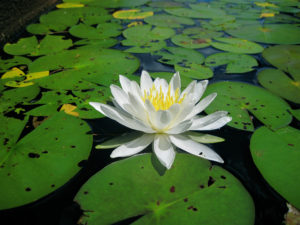Restoring Native Plants in Voyageurs
by Claire Kissane, National Park Service This summer, Voyageurs National Park will begin removing exotic cattails and restoring natural wetlands. The invasive cattails seen throughout the park are actually hybrids of non-native narrow-leaved cattails and native broad-leaved cattail, which has out-competed both parents species, resulting in the vast majority of cattails found in the park being hybridized. These have in turn begin to dominate the landscape because they are more aggressive and can occupy a wider range of water depths than their parent species. Over the past 20+ years, more and more Voyageurs wetlands have been affected by the growing hybrid cattail populations. The invasion has reduced native plant and animal diversity, impaired cultural resources like wild rice, reduced fish and wildlife habitat, and limited the use of waterways for recreation and navigation. Stands of invasive hybrid cattails are also replacing native vegetation such as sedges, wild rice, rushes, pondweeds, and native cattails, causing an overall decline in plant diversity within the park. As boaters are well-aware, these cattails can also form dense floating mats expanding outward from the land. At Voyageurs, most of these dense stands and mats are located on Kabetogama shorelines, with smaller stands on Namakan and Rainy Lakes.
Here is a helpful guide on who to tell cattail species apart.
Here is a great FAQ on native vs. non-native species.

There are an estimated 500 acres of hybrid invasive cattails in Voyageurs National Park. The goal of this project is to control at least half of them in the next 2-3 years, with a long-term plan of controlling the rest of the invasive cattails within the next 5-10 years. This will allow native species to repopulate the bays, restoring natural diversity and habitat to the park area. The project is supported by multiple partners including VNPA and is funded by a variety of sources including the National Park Service and matching donors, VNPA, settlement funds, and the Minnesota Clean Water Land and Legacy Amendment administered through the Initiative Foundation.
Several methods will be used to eradicate the cattails:
- They will be removed mostly using harvesting barges and smaller equipment.
- Any cattails not accessible by heaver equipment will be removed by hand.
- Burning may also be used as a tool to thin cattail areas before harvesting.
- Additionally, native muskrats will be reintroduced to help control the cattails.
Muskrats have the ability to reduce the density of wetland vegetation by eating the plants and making channels through the water, and may be the best long-term method to naturally limit cattail populations before they expand. Since native muskrat populations have decreased in recent years however, animals from outside the park will be introduced to the densest cattail areas within Voyageurs. With an improved habitat, a healthy population of muskrats may help to keep the cattails in check once they are removed.
After the thick mats of hybrid cattails are eliminated, wild rice and other native aquatic plants can take hold without any further effort. Many native seeds can remain in the soil under cattails for years and natural vegetation will return when given the chance. To help the process along, staff will collect and distribute seeds from healthy wetlands in the park, and will go even further by purchasing seed mixtures from local nurseries. The VNPA Volunteer Rendezvous weekend in September will be an important part of the native seed collection, with a goal of collecting 300 pounds of wild rice seed and up to 50 pounds of sedge and rush seed during the volunteer weekend, all from within the park. Within a few days of collection, the seed will be distributed at sites recently cleared of cattails.
Wildlife and plant species living around the cattail mats will be monitored before, during, and after the cattail removal, restoration, and muskrat reintroduction. This will help determine the effectiveness of the restoration methods, and it will help identify any impacts the project might have on wetland ecosystems. Through the efforts of this project, the wetland habitats throughout Voyageurs will once again be healthy and thriving.
Park officials will be primarily working in Black Bay on Rainy Lake outside of the main boating channel this summer. Visitors should inform park staff is they come across a floating mat blocking a campsite or in or near a boating channel.
